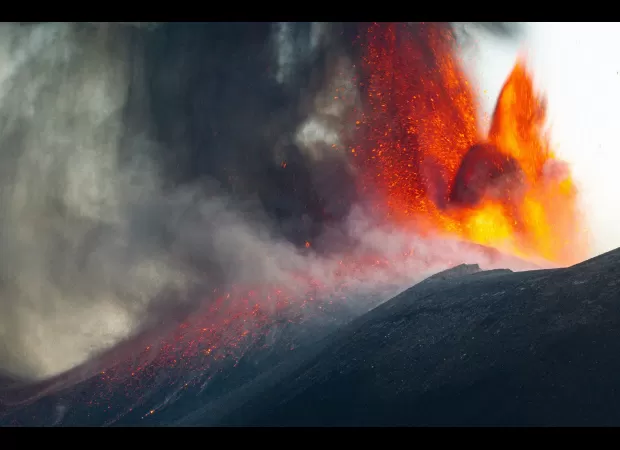Images capture detailed view of Mount Etna eruption, causing flight disruptions.
Text: A highly volatile and sudden release of energy or force.

Last Thursday, Mount Etna, the tallest active volcano in Europe, put on a show of its incredible power as it erupted with a forceful explosion. This fiery spectacle not only captured the attention of onlookers, but also caused disruptions for flights at the nearby Catania Airport. With its frequent activity, Mount Etna is known as one of the most active volcanoes in the world, and has been lighting up the skies in recent days. Not far from there, the Stromboli volcano also joined in on the action, spewing lava into the sea.
Amidst the rumbling and eruptions, photographer and guide Emilio Messina was able to capture stunning images of Mount Etna in Sicily. According to him, the eruption had been building up slowly for several days within one of the volcano's four craters. However, yesterday, there was a significant increase in magma, prompting Messina to safely document the impressive event from a distance. The eruption lasted for several hours, causing a fallout of volcanic ash that led to the closure of Catania Airport and the cancellation of all flights.
Thankfully, the eruption has now subsided, but the aftermath is still causing inconvenience for the surrounding villages and cities. As Messina described, the streets and houses are covered in a thick layer of volcanic ash, reaching up to two centimeters in some places. This may even result in an official increase in Mount Etna's height, as volcanologists await the official measurements.
Standing at 3,357 meters, Mount Etna is the tallest peak in Italy, south of the Alps. While it has erupted multiple times in recent decades, with the last eruption being in December 2023, it is not considered a supervolcano. These types of volcanoes earn their title after a particularly explosive eruption, ranking at eight or higher on the volcanic explosivity index, and spewing over 1,000 cubic kilometers of material. The impact of such an eruption would be catastrophic, reaching far beyond the immediate region.
However, there is another volcano in Italy that scientists are keeping a close eye on. The Campi Flegrei, located in Naples, has been consistently active, and some experts believe it has the potential for a massive eruption, despite not meeting the criteria for a supervolcano. This serves as a reminder of the unpredictable and powerful nature of these natural phenomena, and the importance of continued monitoring and preparation.
22 Views




